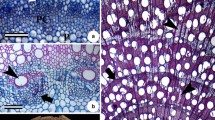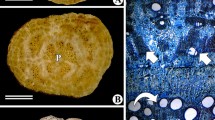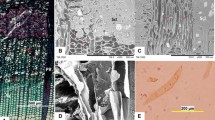Abstract
In Ipomoea hederifolia Linn., stems increase in thickness by forming successive rings of cambia. With the increase in stem diameter, the first ring of cambium also gives rise to thin-walled parenchymatous islands along with thick-walled xylem derivatives to its inner side. The size of these islands increases (both radially and tangentially) gradually with the increase in stem diameter. In pencil-thick stems, that is, before the differentiation of a second ring of cambium, some of the parenchyma cells within these islands differentiate into interxylary phloem. Although all successive cambia forms secondary phloem continuously, simultaneous development of interxylary phloem was observed in the innermost successive ring of xylem. In the mature stems, thick-walled parenchyma cells formed at the beginning of secondary growth underwent dedifferentiation and led to the formation of phloem derivatives. Structurally, sieve tube elements showed both simple sieve plates on transverse to slightly oblique end walls and compound sieve plates on the oblique end walls with poorly developed lateral sieve areas. Isolated or groups of two to three sieve elements were noticed in the rays of secondary phloem. They possessed simple sieve plates with distinct companion cells at their corners. The length of these elements was more or less similar to that of ray parenchyma cells but their diameter was slightly less. Similarly, in the secondary xylem, perforated ray cells were noticed in the innermost xylem ring. They were larger than the adjacent ray cells and possessed oval to circular simple perforation plates. The structures of interxylary phloem, perforated ray cells, and ray sieve elements are described in detail.




Similar content being viewed by others
References
Berlyn GP, Miksche JP (1976) Botanical microtechnique and cytochemistry. The Iowa State University Press, Ames, p 326
Bloch R (1941) Wound healing in higher plants. Bot Rev 7:110–146
Bloch R (1952) Wound healing in higher plants. Bot Rev 18:655–679
Bloch R (1961) General survey. Handb Pflanzenphysiol 14:1–14
Carlquist S (1975) Ecological strategies of xylem evolution. University of California Press, Berkeley, p 243
Carlquist S (1988) Comparative wood anatomy, systematic ecological and evolutionary aspect of dicotyledonous wood. Springer-Verlag, New York
Carlquist S (1991) Anatomy of vines and lianas: a review and synthesis. In: Putz FE, Mooney HA, Bullock SH (eds) Biology of vines. Cambridge University Press, Cambridge
Carlquist S, Hanson MA (1991) Wood and stem anatomy of Convolvulaceae: a survey. Aliso 13:51–94
Carlquist S, Zona S (1988) Wood anatomy of Papaveraceae, with comments on vessel restriction patterns. IAWA Bull 9:253–267
Ceccantini GCT, Alfonso VA (2000) Perforated ray cells in Bathysa meridionalis (Rubiaceae). IAWA J 21:77–82
Chalk L, Chattaway MM (1933) Perforated ray cells. Proc R Soc Lond B 113:82–92
Chavan RR, Shah JJ, Patel KR (1983) Isolate sieve tube(s)/elements in the bark of some angiosperms. IAWA Bull 4:255–263
Committee IAWA (1989) List of microscopic features for hardwood identification. IAWA Bull 10:221–332
Dayal R, Vijendra RR, Sharma B (1984) Perforated ray cells in wood of Indian Myrsinaceae and Loganiaceae. IAWA Bull 5:225–228
den Outer RW, van Veenendaal WL (1981) Wood and bark anatomy of Azima tetracantha Lam. (Salvadoraceae) with description of its included phloem. Acta Bot Neerl 30:199–207
Ellmore GS, Ewers FW (1985) Hydraulic conductivity in trunk xylem of elm, Ulmus americana. IAWA J 6:303–307
Esau K (1964) Plant anatomy. Wiley Eastern University Edition, Santa Barbara
Esau K (1969) The phloem. (Handbuch der Pflanzenanatomie, Histologie Band 5, Teil 2) Encyclopedia of plant anatomy. Gebruder Borntraeger, Berlin
Evert RF (2006) Esau’s plant anatomy, 3rd edn. John, Hoboken, pp 103–131
Fischer A (1884) Untersuchungen über das siebrohren-system der Cucurbitaceen. Gebruder Borntraeger, Berlin
Fischer JB, Ewers FW (1989) Wound healing in stems of lianas after twisting and girdling injury. Bot Gaz 150:251–265
Fukuda Y (1967) Anatomical study of the internal phloem in the stems of dicotyledons, with special reference to its histogenesis. J Fac Sci Univ Tokyo Sect 3(9):313–375
Gautheret RJ (1959) La culture des tissus vegetaux. Techniques et realizations. Masson et Cie, Paris
Johansen DA (1940) Plant microtechnique. McGraw-Hill, New York
Lev-Yadun S, Aloni R (1991) Polycentric vascular rays in Suaeda monoica and the control of ray initiation and spacing. Tree Struct Funct 5:22–25
Lowell C, Lucansky TW (1986) Vegetative anatomy and morphology of Ipomoea hederifolia (Convolvulaceae). Bull Torrey Bot Club 113:382–397
McLean JD, Richardson PE (1973) Vascular ray cells in woody stems. Phytomorphology 23:59–64
Mennega AMW (1969) The wood structure of Dicranostyles (Convolvulaceae). Acta Bot Neerl 18:173–179
Merev N, Gercek Z, Serdar B, Ersen Bak F, Birturk T (2005) Wood anatomy of some Turkish plants with special reference to perforated ray cells. Turk J Bot 29:269–281
Metcalfe CR (1935) The structure of some sandalwood and of their substitutes and of some other little known scented woods. Kew Bull 4:165–194
Metcalfe CR, Chalk L (1950) Anatomy of the dicotyledons. Clarendon Press, Oxford
Nazma BS, Vijendra Rao R (1981) Occurrence of perforated ray cells in the wood of Dryptes roxburghii (Wall.) Hurusava. IAWA Bull 2:201–202
Pant DD, Bhatnagar S (1975) Morphological studies in Argyreia Lour (Convolvulaceae). Bot J Linn Soc 70:45–69
Rajput KS (2003) Structure of cambium and its derivatives in the compressed stem of Canavalia ensiformis (L) DC (Fabaceae). Phyton 43:135–145
Rajput KS, Rao KS (1997) Occurrence of sieve elements in phloem rays. IAWA J 18:197–201
Rajput KS, Rao KS, Patil UG (2006) Stem anatomy of Dolichos lablab Linn (Fabaceae): origin of cambium and reverse orientation of vascular bundles. Flora 201:65–71
Rajput KS, Raole VM, Gandhi D (2008) Radial secondary growth, formation of successive cambia and their products in Ipomoea hederifolia L. (Convolvulaceae). Bot J Linn Soc 158:30–40
Roelosfsen P (1959) The plant cell wall. In: Handbuch der Pflanzenanatomie Band 3, Teil 4. Gebruder Borntraeger, Berlin
Schenck H (1893) Beiträgezur biologie und Anatomie der Lianen. II. In: Schimpers AFW (ed) Botanischen Mittheilungen Tropischen vol 5. Fischer, Jena, pp 1–271
Serdar B, Gercek Z, Merev N (2004) Perforated ray cells in Salix rizeensis (Salicaceae). IAWA J 25:119–120
Shah JJ, Nair GM, Thanki YJ, Kothari IL (1983) Isolated sieve tube elements in the fruit of Coccinia grandis (L.) Voigt (Cucurbitaceae). Ann Bot 51:251–253
Sieber M, Kucera LJ (1980) On the stem anatomy of Cleimatis vitalba L. IAWA Bull 1:49–54
Sonsin JC, Machado SR, Marcati CR (2008) Perforated ray cells in the wood of roots and branches of Cerrado species from Brazil. IAWA J 29:291–299
Steward FC, Mohan Ram YH (1961) Determining factors in cell growth: some implications for morphogenesis in plants. Adv Morphog 1:189–265
Terrazas T, Aguilar-Rodríguez S, Ojanguren CT (2011) Development of successive cambia, cambial activity, and their relationship to physiological traits in Ipomoea arborescens (Convolvulaceae) seedlings. Am J Bot 98:765–774
Thanki YJ (1978) Development and structure of some Cucurbitaceous fruits. Ph.D. thesis, Sardar Patel University, Vallabh Vidyanagar
Acknowledgments
The authors are thankful to the University Grants Commission (UGC) of the Government of India for financial support. Our thanks also go to Dr. J. L. Mueller, Dr. Hartwig Leuthen, and anonymous reviewers for their valuable suggestions on the manuscript.
Author information
Authors and Affiliations
Corresponding author
Rights and permissions
About this article
Cite this article
Rajput, K.S., Patil, V.S. & Rao, K.S. Wood Anatomy and the Development of Interxylary Phloem of Ipomoea hederifolia Linn. (Convolvulaceae). J Plant Growth Regul 32, 654–662 (2013). https://doi.org/10.1007/s00344-013-9334-8
Received:
Accepted:
Published:
Issue Date:
DOI: https://doi.org/10.1007/s00344-013-9334-8




